Touring in Norfolk and Suffolk with Theodore Bent…
By Nigel W. Gresley, October 28, 1896
The printing kindly contributed by Witmore & Son, Dursley
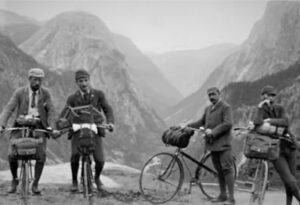 On several former occasions when I have been fortunate enough to have the opportunity of travelling in Norway, or Wales, or Ireland, I have written some short account of our experiences, which has appeared either in the world-renowned “Gazette”, or in the Parish Magazine, which by-the-bye is sent monthly to interested friends in Africa, America, and Australia, as well as to Sarawak in the far distant country of Borneo; so that the knowledge of our local doings has a world-wide circulation, of which we may well be proud, but which ought to make us very circumspect in our behaviour at home! So kindly a mention has frequently been expressed of my humble efforts to describe what we have seen and heard, that I am inspired to write a short and true account of a little Holiday Trip which I have lately made with an old school and college friend, who has become, during the last few years, an Oriental traveller and explorer of wide reputation, Mr. J. Theodore Bent.
On several former occasions when I have been fortunate enough to have the opportunity of travelling in Norway, or Wales, or Ireland, I have written some short account of our experiences, which has appeared either in the world-renowned “Gazette”, or in the Parish Magazine, which by-the-bye is sent monthly to interested friends in Africa, America, and Australia, as well as to Sarawak in the far distant country of Borneo; so that the knowledge of our local doings has a world-wide circulation, of which we may well be proud, but which ought to make us very circumspect in our behaviour at home! So kindly a mention has frequently been expressed of my humble efforts to describe what we have seen and heard, that I am inspired to write a short and true account of a little Holiday Trip which I have lately made with an old school and college friend, who has become, during the last few years, an Oriental traveller and explorer of wide reputation, Mr. J. Theodore Bent.
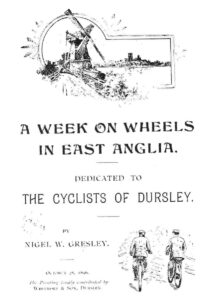
I venture to dedicate this small sketch to the “Cyclists of Dursley”, because being a bit of a cyclist myself, I am very conscious of the wonderful bond of sympathy and interest which exists between all cyclists, so that when they meet, the “Bike” and its doings, some becomes the one absorbing topic of conversation. I hope, therefore, that the history of “A Week on Wheels in East Anglia” may prove of some slight interest to my many cycling friends, and also to others who are intending to acquire the art, which as Dr. Turner said the other day at the Sanitary Congress in Liverpool, is calculated to improve the health and physical strength of both men and women alike, provided that it is done in moderation, and (may I add) that they do not ride uphill!
The craze for cycling has become universal, men, women, and children in almost every country having taken to it like ducks to the water. Its attractions seem irresistible, and its utility so great that it is not at all likely that it will go out of fashion, unless a Radical Government puts a Tax on the Bicycle.
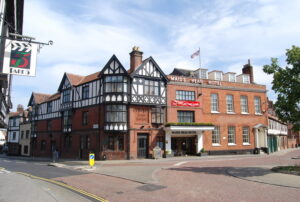
Starting from Dursley one Monday morning, we took the train to Paddington, placed our two machines on the top of a “Four-wheeler”, and drove to Liverpool Street Station just in time to see the tail of the Norwich Express disappearing around the corner. I was told by the Porters that during the last summer the number of Bicycles leaving Liverpool Street every week was over a thousand. We had a good journey to Norwich, passing through the rich and prosperous looking County of Suffolk, and its ancient capital Ipswich.
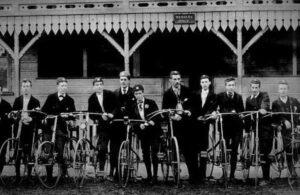
At Norwich the “Maid’s Head” Hotel proved exceedingly comfortable and interesting with its old-fashioned courtyard and panelled rooms, its title referring to Elizabeth, the “Maiden Queen”. We can strongly recommend it, especially as it is the “Head Quarters” of the Cyclist Touring Club, and they gracefully deducted from our “Bill” the discount to which we were entitled as members of the C.T.C. By-the-bye, our experience led us to the conclusion that it does not always answer to trust to the hotels recommended by the C.T.C.; but we must not individualize.
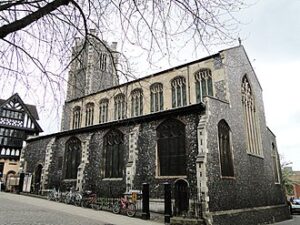
Next morning [Tuesday] we inspected the quaint old town of Norwich, with its fine Castle, and Gateways, and myriad Churches, one of which belongs to our old friend Rev. R.A. Hunter, formerly Vicar of Lower Cam, whose health, we are glad to say, is much improved. Having visited the Cathedral, we mounted our Bikes for a 20 mile run to Yarmouth. The road is comparatively level, and picturesque with trees and several small villages. A curious feature of the Churches in East Norfolk is their circular towers, often with an octagonal top, and thatched naves; the effect is quaint but not pretty.
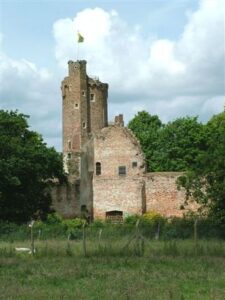
On approaching Yarmouth we visited the massive remains of Caistor Castle, close to the sea, which reminds us of parts of Kenilworth Castle, though on a smaller scale. We lunched at a smart new hotel on the beach, and had to pay dearly for its smartness, it being the most expensive luncheon in our united experiences. Great Yarmouth is a very old and interesting town, with its immense market place, its magnificent Church, its old Rows, i.e. a succession of very narrow streets or lanes, bearing odd names such as “Hell Row”, “Kitty Witches Row”, “Dame Aveline’s Row”, and so on, and necessitating very narrow carts, which were here first called “Trollies”, or in King Henry VIII’s time “Harry Carriers”, its handsome quays for shipping, its weird and gruesome prisons, its many momentoes of England’s Naval Hero, Nelson, whose birthplace is in Norfolk. Notwithstanding that the Church claims to be the largest Parish Church in England, we were much disappointed in it, greatly preferring S. Michael’s, Coventry, and still more our own Church of S. Mary Redcliffe, both of which may well claim superiority over S. Nicholas, Great Yarmouth.
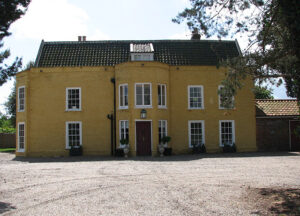
In the evening we bicycled on for six miles to Fritton Old Hall in Suffolk, where we stayed for the night in a delightful old Manor House Farm on the border of Fritton Broad, a lovely sheet of water, surrounded by pine trees. Next morning my friend sketched whilst I fished, the result being similar on each occasion, that he had a highly interesting memorial to shew his friends, whilst I had nothing at all! The sport being execrable. There were, as usual, plenty of stories of gigantic pike being taken, but the extent of my catch during our stay in East Anglia was one fish about as long as this page. If the proverb be true that “Patience is a virtue”, I flatter myself that there is scarcely a more virtuous person living in Gloucestershire.
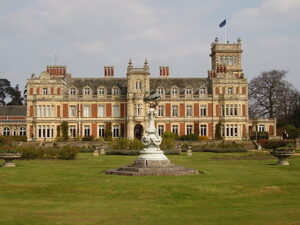
Leaving Fritton Old Hall in lovely sunshine [Wednesday] we biked [10 miles – ed.] on to Lowestoft, passing through beautiful pinewoods and heather, with the level green plains of the River Waveney on our right, dotted about with white sails of many sized yachts, which flitted hither and thither like huge seagulls. We saw the fine house and park of Somerleyton, which was first built and inhabited by Sir Morton Peto, Bart., the father of our good friend and neighbour Mr. F.K. Peto, of the Rangers, Dursley. The memory of Sir Morton Peto is held in high esteem in this part of East Anglia, inasmuch as he was the founder and maker of the now large and prosperous town of Lowestoft, hard by.
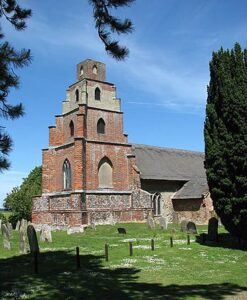
We visited the fish quays which present a busy scene, owing to the extent and importance of the fishing industries carried out at this port. Every day immense quantities of fish of all kinds are unshipped from the Smacks returning with their week’s catch in the German Ocean and the North Sea. An auction is held of each cargo on landing, and the fish are then sorted and packed in ice, and at once despatched to the London and chief provincial markets. We bicycled [3 miles – ed.] thence to Oulton Broad, which was covered with sailing Boats and large Wherries, the day being fine and breezy. Having put our machines on board, we skimmed along for 8 miles [on the Waveney River – ed.] to visit Burgh S. Peter’s Church, which stands on an eminence, and has a peculiar tower, consisting of five square portions standing upon each other, and each smaller than the portion below it. Perhaps it has served in olden times as a Beacon Tower in the midst of the spreading plains around.
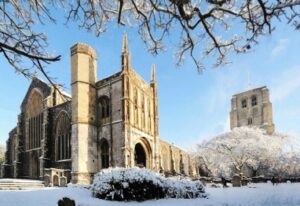
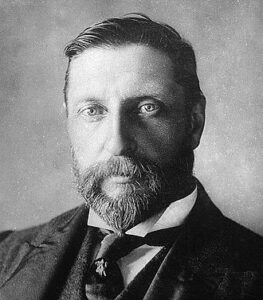
From Beccles we hastened on [8 miles – ed.], reaching Ditchingham about dusk. We had the pleasure of staying at Ditchingham House, where we were most kindly and agreeably entertained by Mr. Rider Haggard, the well-known and talented author of many leading Works of Fiction, notably, perhaps, the novels “She”, “King Solomon’s Mines”, and “Jess”. Mr. and Mrs. Rider Haggard are surrounded in their home by innumerable objects of art, carved oak, statuary, paintings illustrating scenes from his works, and many rare and valuable Curios picked up during their travels in Mexico, South Africa, and other parts of the world. We greatly enjoyed our 24 hours stay under their hospitable roof.
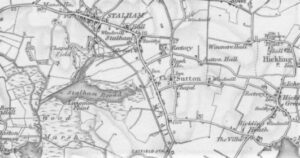
From Ditchingham [Thursday] we travelled to Stalham [approx 30 miles – ed.], where we stayed the night at a little roadside inn; it seems the custom in Norfolk to have a kind of Annexe attached to the village inn with separate door, &c., where travellers can find a sitting-room and bedroom accommodation. They are perhaps small, but always clean and comfortable, and so far as our experience went the Host and Hostess were invariably civil and obliging, and well informed.
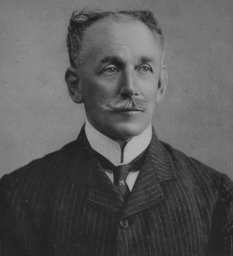
At Stalham we dined with Sir Elwin and Lady Palmer. He is Financial Secretary to the Khedive in Egypt, and we learnt much interesting information as to Egyptian affairs, and the splendid doings of our soldiers in the Dongola Campaign.
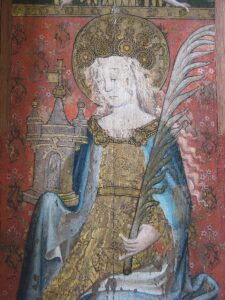
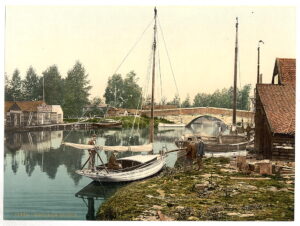
We may, perhaps, explain that the Broads of Norfolk and Suffolk are extensive sheets of water, varying from one mile to ten miles in length, being formed by the broadening out of one of the many rivers which intersect these counties; the waterways of East Norfolk seemed to us to be as numerous as the roadways and are much used for commerce, as well as for pleasure boats; in fact they more or less resemble a number of Sharpness and Gloucester canals running in various directions. The Broads are very picturesque, being usually fringed with trees and high graceful rushes; and are the haunt of multitudes of wild fowl, and herons, and pike of fabulous size, besides small fry.
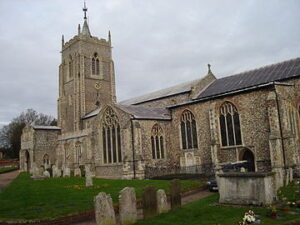
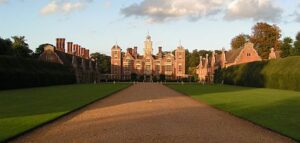
From Aylsham we biked to Blickling [1.5 miles – ed.], where the Marchioness of Lothian gave us leave to wander about the private gardens, and sketch to our heart’s content. Blickling Hall is one of the finest Elizabethan Mansions in England, built of red brick and stone and round a quadrangle, with a lofty tower and many oriel windows. The park, and the deer, and the lake, and the splendid trees form a perfect picture of one of the Stately Homes of England, and it was with regret that we found it was time to move on.
Leaving Blickling about 5 p.m., we unluckily missed our way to Cromer [21 miles – ed.], and rain and darkness coming on, we had a really bad time of it, having to strike matches and swarm up signposts to discover our whereabouts.
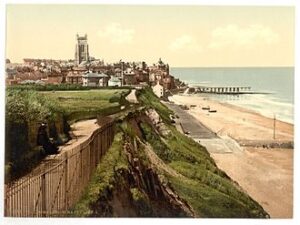
At last we beheld the lights of Cromer in the distance; and descending the hill with much difficulty in the dark having no lamps, it is a mercy Mr. Superintendent Hopkins did not turn up just then! – we crept like two drowned rats to our hotel; seldom indeed being so thankful to reach a journey’s end, and having put our faithful bikes to bed, in a coach house, without any supper, we found every luxury for ourselves, which we thoroughly enjoyed.
The next day being Sunday, the morning service was attended, the music being excellent, and the congregation enormous. About mid-day we went on to Sheringham, and thence by Holt to Binham Abbey [17 miles – ed.], where we went to the afternoon service, and listened to a sermon about “Ichtheosauri and other gigantic mammalia”, the dear old clergyman giving us a dissertation upon the Geology of the Coal Fields of Great Britain, and our duty of gratitude towards the Giver of all good, Binham Abbey is surrounded by extensive ruins, the Church consisting of a fine Norman Nave with a richly carved West Front of the Early English period. It belonged in old days to the Abbey of S. Albans, Herts, whence the Abbot paid annual visits in great state to Binham.
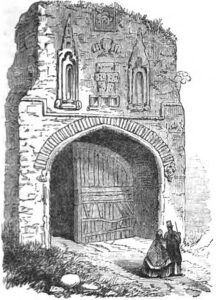
From Binham Abbey we rode on to see the grand old Abbey of Walsingham [5 miles – ed.], of which the great east window and other portions still remain in the grounds of Mr. Lee-Warner. It was founded in 1061, and belonged to Augustine Canons. Its wealth was very great, since it contained the well-known image of “Our Lady of Walsingham”. So many Pilgrims visited the Shrine, that the road thither was known as the “Walsingham Way”, a name also given to the Milky Way, which was supposed to guide Pilgrims to the Image. We drank of the water in the Wishing Wells, which still stand within the sacred enclosure; my wish being that I may always find grace to act worthy of the name of “Walsingham” which I bear. The evening service in Walsingham Church was bright and hearty, though the chants were Gregorian, which I do not think equal to Anglican.
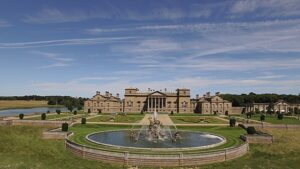
Next morning [Monday] we went to Wells [9 miles – ed.] and prepared for a long day’s cycling. First we rode across Holkham Park, the seat of the Earl of Leicester, which lies within a high brick wall ten miles in circumference, being the longest park wall in England. The timber is very fine, and the house which is no less than 344 feet long, stands on the edge of a lake.
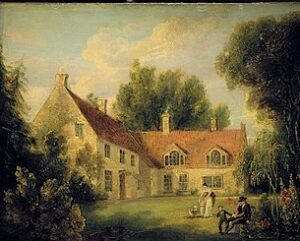
Leaving Holkham we came to Burnham Thorpe, a sweet little village lying in a valley with a stream, and an old moated grange, and a handsome Church, and quaint farm buildings. This village is justly celebrated as having been the birthplace of the immortal Nelson, several of whose relics and autographs when a boy, we were shown in the Church. A handsome Parish Institute has lately been built in Burnham Thorpe by public subscription, as a memorial to the Hero of Trafalgar.
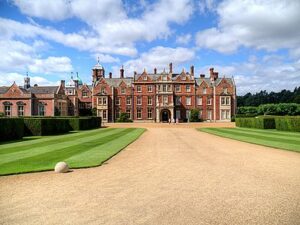
Mounting our bikes, we rode steadily on through the village of Heacham, [Thornham ? – ed.] and up the hill until we reached the thriving town of Hunstanton on the Wash [19 miles – ed.], with its conspicuous Lighthouse, built in 1840, which is so arranged that a special red gleam is thrown on a sandbank called the “Roaring Middle”. On a clear day the coast of Lincolnshire and the fine tower of Boston Church are easily visible. From Hunstanton we passed the villages of Snettisham and Dersingham till we reached the confines of the Royal Residence of Sandringham [10 miles – ed.]. We were shown privately all over the beautiful gardens and terraces, and heard much of the kindnesses and liberality of H.R.H. the Prince of Wales and our beloved Princess, towards rich and poor alike, on their Norfolk estates. Sandringham is situated in the prettiest spot that we saw in East Anglia; pine woods and heather and rhododendrons and sandy glades abounding in all directions. The village Church, too, abounds in mementoes of the Royal Family, placed there by the Queen and the Prince.
One of the most touching signs of true Royal Greatness being a Tombstone in the churchyard, erected by the Prince to his Head Groom who lay dangerously ill with Typhoid Fever at the same time as the Prince. The Groom died, the Prince recovered. On the Tombstone are these simple words “One was taken, and the other left”.
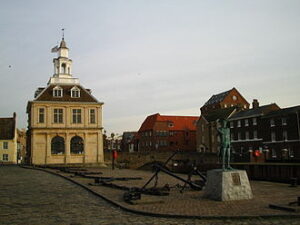
Commencing our week’s trip with Norwich Cathedral and ending with Sandringham House, we felt that we had done our duty to both “Church and State” in the good old county of Norfolk, and that we might take our leave in peace, so we bicycled on to Castle Rising and having duly examined the marvellous old ruins and earth works, hastened forward to King’s Lynn [8 miles – ed.].
[Tuesday] Here we did some shopping and saw the Parish Church, containing two of the finest Monumental Brasses in the kingdom. Returning to the station we caught the midday express to London, where I parted with my Friend, and continuing the journey by rail to Stonehenge, reached home about 9 p.m., safe and sound.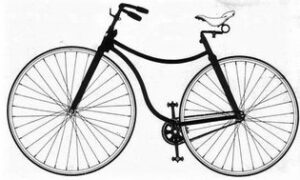
In conclusion, it may interest my cyclist friends to know that during our “Week on Wheels in East Anglia” we travelled on our respective bicycles upwards of 200 miles along excellent roads, only meeting with two mishaps, once being knocked head over heels by that new terror to the human race “the scorcher”, and once puncturing a tyre; but happily in neither case was the result serious.
It will also be seen that during our eight days absence from Dursley we contrived to visit numbers of interesting localities, and learn many practical lessons in the geography and history of by no means the least interesting portion of Old England.
I hope that this short sketch may induce other enterprising cyclists to favour us with an account of their experiences.
Nigel W. Gresley
Map of the Journey
 Leave a comment or contact us about this article
Leave a comment or contact us about this article